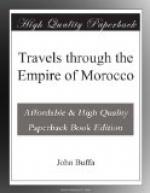Several of the aqueducts, which were constructed by the Carthaginians and Romans, are still to be seen; and the ruins of amphitheatres, and other public buildings, are found in the town and neighbourhood of Fez: likewise many Saracen monuments of the most stupendous magnificence, which were erected under the Caliphs of Bagdad. The mosques and ruins are frequented by a great number of storks, which are very tame, and are regarded by the Moors as a kind of inferior saints.
The baths here are wonderfully well constructed for the purpose. Some of them are square buildings, but the greater part are circular, paved with black or white polished marble, and containing three rooms: the first for undressing and dressing, the second for the water, and in the third is the bath. Their manner of bathing is very curious: the attendant rubs the person with great force, then pulls and stretches the limbs, as if he meant to dislocate every joint. This exercise to these indolent people is very conducive to health.
The bazars in which the tradesmen have their shops, are very extensive. These shops are filled with all kinds of merchandise. In the centre of the town is a rectangular building, with colonnades, where the principal merchants attend daily to transact business.
The inhabitants of Fez are of a large muscular stature, fair complexion, with black beards and eyes; extremely amorous and jealous of their women, whom they keep strictly guarded. Their houses consist of four wings, forming a court in the centre, round which is an arcade, or piazza, with one spacious apartment on each side. The court is paved with square pieces of marble, and has a basin of the same in the centre, with a fountain. They keep their houses remarkably clean and neat; but all the streets of this immense town are narrow, very badly paved with large irregular stones, and most shockingly dirty. The tops of their houses, like those of Tetuan, and other towns in Barbary, are flat, for the purpose of recreation.
Among the remnants of several amphitheatres, there is one very nearly entire, which is kept in constant repair at the expense of the Emperor, and appropriated as a menagerie for lions, tigers, and leopards. As I was contemplating it the other day, I felt at a loss to account for this being kept in repair, while the others were suffered to moulder into dust, unheeded, excepting a very few, and those but partially prevented from sharing the general wreck. I had stood some time, thus employed, when I was suddenly interrupted in my meditations, by the sound of voices close behind me; on turning I perceived two Jews, one of whom I knew very well, from having given advice to some part of his family. I immediately inquired how it happened that the building before us was so carefully preserved from going to ruin, as happened to most of the others. He informed me, that it was a kind of menagerie for wild beasts. “It was the same in the time of the late Emperor,” continued he; “and a very curious incident befell one of my brethren in that place.” As the narrative was not merely very curious, but really wonderful, I cannot forbear sending you the substance of it; as to give it you in the very circuitous way it came to me, would be rather a tax upon your patience, particularly, as you may not be so destitute of resources of amusement, as, I confess, I was at that moment.




